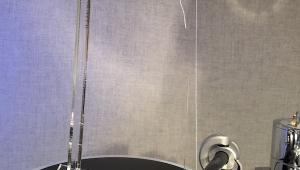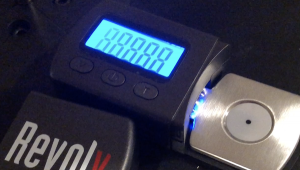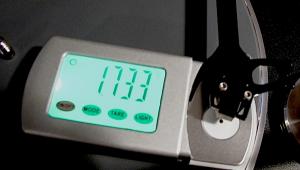Jolida’s Foz XT-R Crosstalk Reduction Device

Many if not most gimbaled-bearing tonearms don’t allow for axial tilt adjustment to set azimuth.
With arms that do, unipivot or gimbal bearing, physically making sure the head shell is parallel to the platter or setting cantilever perpendicularity using a mirror, does not insure correct azimuth setting just as an arm parallel to the record does not assure correct SRA/ VTA.
That’s because on the micro-manufacturing level, there are wide tolerances in, for instance, how precisely is the stylus axially bonded to or inserted into the cantilever. More often than not it’s “off” by a tiny amount, but that tiny amount puts the entire 45/45 system “off-balance”, which produces unwanted crosstalk between the channels. Of course, some crosstalk is inevitable.
Excessive crosstalk using the “parallel/perpendicular” methodology can also be caused by an error in the relationship between the cantilever and the coil (in the case of a moving coil cartridge), or the relationship of the entire “motor assembly” to the cartridge body in which it is housed. This is not an issue for cartridges where the motor is integrated within the body as with Lyra cartridges for example. Given all of these variables, it’s obvious that visually establishing correct azimuth is unreliable.
Where you can physically adjust axial tilt either at the arm’s head shell or elsewhere, you can set azimuth electronically using a digital oscilloscope, a high quality dual channel voltmeter or even with a budget voltmeter using a somewhat clumsy method outlined on the 21st Century Vinyl DVD. Or you can use the handy Fozgometer invented by veteran electronics designer Jim Fosgate.
But what if your arm doesn’t allow for this critical adjustment parameter? Then what? Think of Jolida’s Foz XT-R as an “active Fozgometer”. That is, it does electronically what the Fozgometer helps you adjust mechanically.
To use, you place it in between your phono preamplifier and your preamplifier or integrated amplifier. The big issue there is its transparency and of course there’s the need for another set of interconnects of the same quality as what you normally use between your phono preamplifier and preamplifier (or integrated amp). So add to the XT-R’s cost ($379) the cost of your interconnect cable.
During the recent review of the Oracle Origine MKII turntable I inserted the XT-R between both the Lejonklou Gaio and Graham Slee Ascension phono preamplifiers and my reference darTZeel NHB-18NS preamplifier, even though the Oracle’s unipivot arm allowed for azimuth adjustment.
But first I did a great deal of listening without the device to determine its transparency after insertion. One key LP I played was an original UK Decca pressing of La Fille Mal Gardée (excerpts) (Decca SXL 2313) a minimally miked, astonishingly transparent sounding recording from 1962 that features an enormously wide and deep soundstage. (The original London CS 6252 is equally good and the ORG double 45 reissue is almost as good).
Through the Ortofon 2M Blue installed on the Origine arm, but without checking and/or adjusting the arm’s axial tilt (probably set physically at the Oracle factory), soundstage width was noticeably narrower and somewhat flatter than expected from this recording. Given the cartridge’s $200 cost, it could have just been that.
In this “budget” setting, inserting the “0 gain” XT-R did not produce any audible degradation whatsoever. It was 100% transparent.
However, the meters on the XT-R indicated a considerable azimuth error and thus crosstalk imbalance (which means information meant for one channel was leaking into the other and vice-versa).
Using the XT-R
You’ll need an accurate test LP. The Analogue Productions “The Ultimate Test LP” (AAPT1) is the best currently in print. Once everything is connected and the XTR is powered “on”, you flip up the “active” switch, flip the “calibration” swith to the “left” position and you play the test record’s left channel only 1kHz test tone. The meter now reads the right channel. Adjust the left control knob to achieve the lowest reading (the “null” point). Repeat with the right channel test track and use the right channel knob. The instructions suggest repeating the procedure to insure the best results.
Once you’re finished, you set the “calibrate” switch to the center position and leave the “active/off” switch in the “active” position to hear the results. You can switch it to “off” to hear the difference. The “left” knob required a considerable adjustment.
But rather than do that I just sat down and played again La Fille Mal Gardée (excerpts) and the difference was easily noticeable: much wider soundstage, greater depth and a presentation that more closely resembled the staging produced by my reference system.
Then I repeated the entire exercise using a 12” VPI “Fatboy” gimbaled bearing arm mounted on a VPI Avenger (both currently under review for Stereophile), using an Ikeda 9Gss ($10,500) limited edition cartridge.
Here the cartridge build quality was appropriately high so very little correction was required—not enough to make a noticeable spatial difference, but the insertion of the device, the additional cabling and connections resulted in a very slight loss of “airy transparency” on the strings. The flute lost a tiny bit of air and the delicate triangle lost a bit of decay.
One hopes a $10,000 cartridge would be rigorously tested and the Ikeda was. In fact, over the years I’ve found that costly cartridges are mostly as advertised.
So my conclusion is that the Jolida XT-R is an extremely useful device in moderately priced systems where whatever sonic loss in incurred by inserting it into the link between the phono preamp and preamp will be inaudible, while the spatial gain may be considerable and well worth the money.
Where the cutoff point is located I can’t say, but at the upper end of the performance and cost spectrum, the XT-R is not useful both because it’s not 100% transparent and because cartridges at this end of scale usually need little or no axial tilt correction (or at least they shouldn’t!) and whatever small improvement might be gained in spatial performance is not worth the slight loss of transparency.
That said, the XT-R produced a major improvement in a modestly priced front-end and if you can get one of these to try with a money back if it doesn’t work in your system, I’d not hesitate to try it. (Note: the online specs say the unit is “phase inverting”, which I take to mean it inverts polarity. If you think this is an issue for you try reversing your speaker leads on both channels and determine if you hear a difference either way using minimally miked recordings).
Gain: Unity
Input impedance: 71K
Output impedance: 400 ohms
Signal to noise ratio: >90dB “A” weighted
Distortion: > 0.25% (1kHz)
Perfect square wave response
Frequency response









































